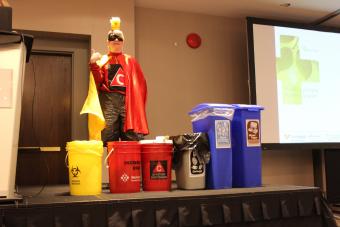Photo: Teri Guimond demonstrates the types of materials that belong in each container for proper disposal at health-care facilities
Health care generates a lot of waste. Knowing whether something is recyclable, garbage, biomedical or chemical is key to making sure waste ends up in the right place to reduce the risk to staff, vendors, workers and even patients. This also ensures that it’s collected and packaged in accordance with regulations while ensuring a safe and healthy planet. According to Teri Guimond, hazardous waste coordinator for the Lower Mainland health organizations, disposal of materials in the wrong place, or an incorrect liner or container, can be both dangerous and costly.
Workplace hazards
One of the concerns when it comes to improper waste disposal in health care is the risk of workplace injuries. “Much too often, I hear about Environmental Services/Housekeeping staff being cut by scalpels or poked by needles because they were in the garbage, when they should be disposed of in a sharps container. Incorrect disposal situations like this can then extend to the people working in landfills, recycling sorting plants and end treatment facilities where they face the same risks,” Teri says.
Privacy concerns
Teri also encourages staff to be aware of patient privacy. “I have heard stories where staff have disposed of items with patient names still on them in the garbage, thinking that all hospital waste is incinerated. This is not the case, as not all of our garbage gets burned.”
To illustrate her point, Teri likes to offer the visual of a crow at the landfill. “Just because something is in a black garbage liner does not mean it will not be seen. Most people wouldn’t ever think that a crow is capable of exposing patient information. But these creatures can bring this information into plain view by ripping open a black garbage bag at the landfill and flying away with non-compliant items, such as a blood bag or labels with patient information that we thought were destroyed.”
Economic implications
Improper waste management also results in significant economic implications. Recyclables, garbage, chemicals and all types of biomedical waste each have very specific regulatory requirements or treatments to make them safe for end disposal or suitable for processing. Depending on the waste type, disposal can cost 10 to 20 per cent more than garbage. In addition, when empty or unused biomedical waste, containers or liners with a biohazardous symbol are discovered where they shouldn’t be, we risk facility shut downs for investigation, bans from disposal facilities, fines, surcharges and more.
“Any garbage sorted into any type of biomedical container will be processed at a much higher disposal rate, unnecessarily increasing our overall costs. When auditing containers, I have even seen half-eaten ham sandwiches placed in biomedical waste containers when they should have gone to the organics or garbage,” Teri explains.
She offers the following tips for practicing proper waste management for health-care facilities and in an office environment.
Health-care facilities
- Remove labels with patient information from garbage items where possible; that way the item can go into the garbage and the label into shredding. If it is not possible to remove the information from an item, drain and dispose of the item in a yellow non-anatomical biomedical waste container.
- Place recycling containers at least a foot away from yellow biomedical containers.
- To prevent contamination, never place recycling containers in fast-paced, high-risk areas (e.g. Emergency Department trauma rooms).
Office
- VHS and DVDs containing personal patient information must be disposed of in confidential mixed-media bins.
- Dispose of the following items in the garbage: binders, wrappers for candy, chips, cookies and plastic bags.
- Empty and rinse all containers, and remove lids before recycling.
Learn more
An updated LearningHub module, Waste Management Basics, is available for staff to learn about the ins and outs for responsible waste disposal. The module covers:
- Examples and definitions of the different waste types, including biomedical, pharmaceutical, chemical, radioactive, garbage, recycling and confidential
- What the different waste colours mean, containers to use and if a liner is acceptable or not
- Why it’s important to get it right








